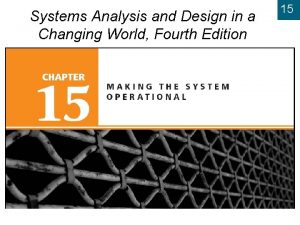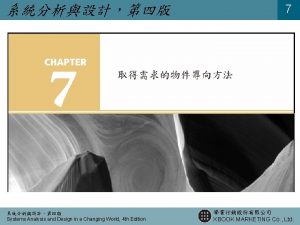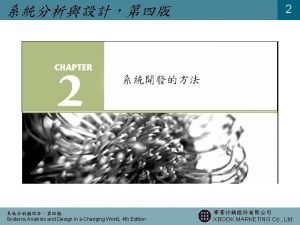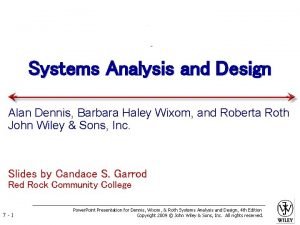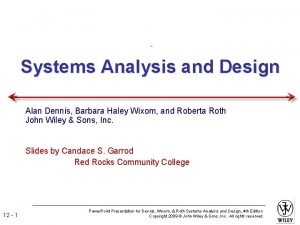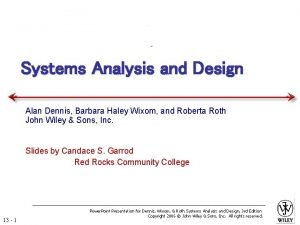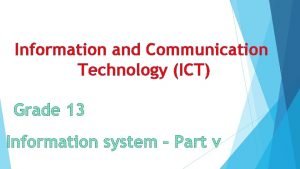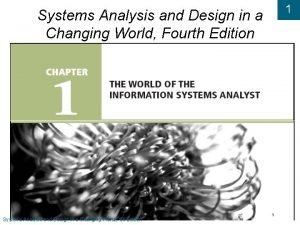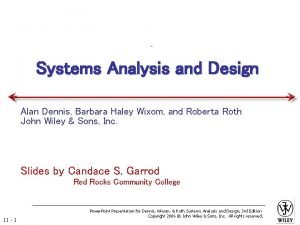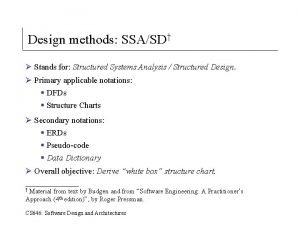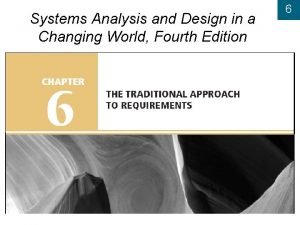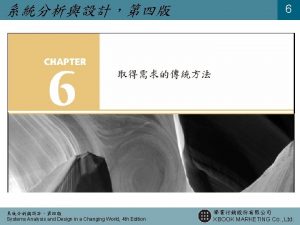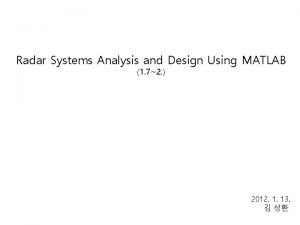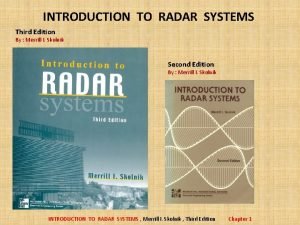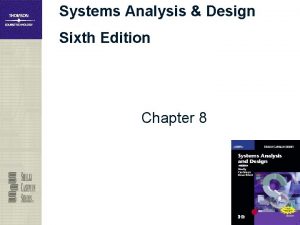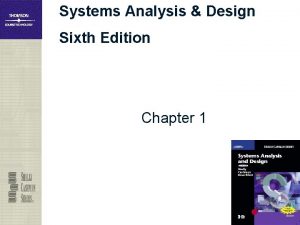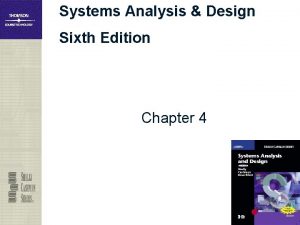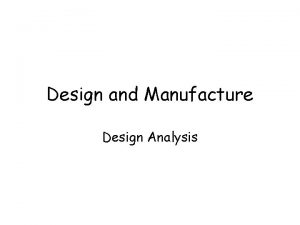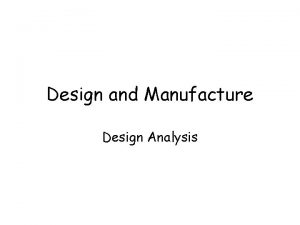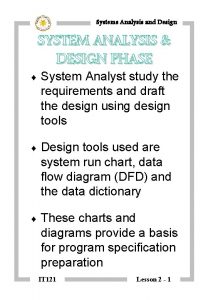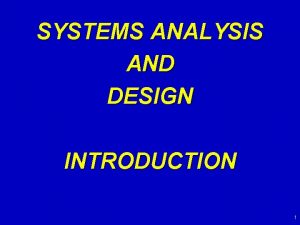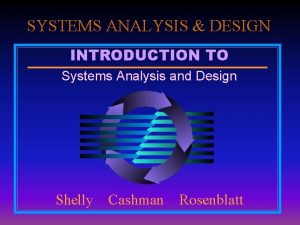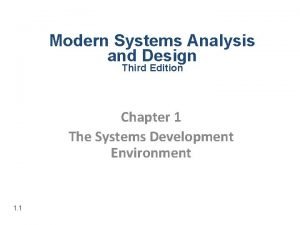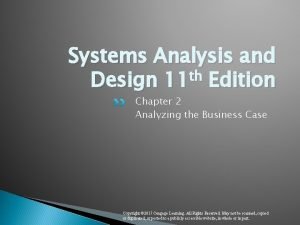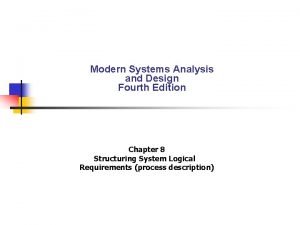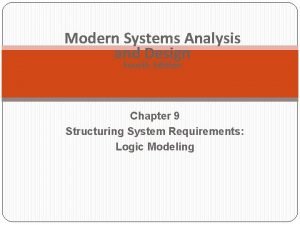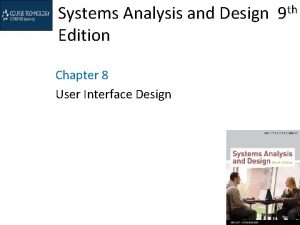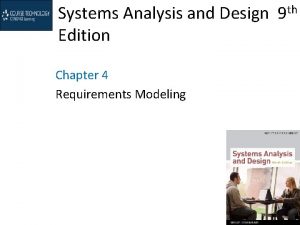Systems Analysis and Design 5 th Edition Chapter




















































- Slides: 52

Systems Analysis and Design 5 th Edition Chapter 8. User Interface Design Roberta Roth, Alan Dennis, and Barbara Haley Wixom © Copyright 2011 John Wiley & Sons, Inc. 8 -0

Chapter 8 Outline §Principles of user interface design. §User interface design process. §Navigation design. §Input design. §Output design. © Copyright 2011 John Wiley & Sons, Inc. 8 -1

INTRODUCTION § Interface design is the process of defining how the system will interact with external entities. § In this chapter, we focus on the design of user interfaces – how the system will interact with the users. § The design of system interfaces defines how the systems exchange information with other systems. © Copyright 2011 John Wiley & Sons, Inc. 8 -2

(cont’d) § The user interface includes three fundamental parts: - The Navigation mechanism - the way in which the user tells the system what to do. - The input mechanism – the way in which the system captures information. - The output mechanism - the way in which the system provides information to the user or to other systems. § Graphical user interfaces (GUI) use windows, menus, icons, etc. , and are the most common type of user interfaces. © Copyright 2011 John Wiley & Sons, Inc. 8 -3

PRINCIPLES FOR USER INTERFACE DESIGN §User interface design is an art. §The goal is to make the interface pleasing to the eye and simple to use, while minimizing the user’s effort. © Copyright 2011 John Wiley & Sons, Inc. 8 -4

(cont’d) © Copyright 2011 John Wiley & Sons, Inc. 8 -5

Layout § Layout refers to organizing areas of the screen and document for different purposes and using these areas consistently throughout the user interface. § The screen is often divided into three areas: – The top area provides the user with ways to navigate through the system; – The middle and the largest area is for display of user’s work; and – The bottom area contains status information about that the user is doing. © Copyright 2011 John Wiley & Sons, Inc. 8 -6

(cont’d) § The areas and information within areas should have a natural intuitive flow to minimize user’s movement from one area to the next. § Ideally, the areas will remain consistent in – size, – shape, – placement for the forms, and – reports used to present it. © Copyright 2011 John Wiley & Sons, Inc. 8 -7

(cont’d) § Web page layout with multiple navigation areas © Copyright 2011 John Wiley & Sons, Inc. 8 -8

(cont’d) The flow between sections should also be consistent. © Copyright 2011 John Wiley & Sons, Inc. 8 -9

Content Awareness § Content awareness refers to the ability of an interface to make the user aware of the information it contains. § All interfaces should have titles. § Menus should show where the user are and where the user came from to get there. § All area should be clear and well defined. § Content awareness also applies to the fields and field labels within each area, and the information that a form or report contains. © Copyright 2011 John Wiley & Sons, Inc. 8 -10

Aesthetics § Aesthetics refers to designing interfaces that pleasing to the eye. § Interfaces need to be functional and inviting to use. § In general, all forms and reports need a certain amount of white space. § The design of text is also important. – Fonts and font sizes – Colors and patterns © Copyright 2011 John Wiley & Sons, Inc. 8 -11

(cont’d) An example of form with high density © Copyright 2011 John Wiley & Sons, Inc. 8 -12

User Experience § User experience refers to designing the user interface with the users’ level of computer experience in mind. § Novice users are concerned with easy of learning. § Expert users are concerned with easy of use. § Often, the two objectives are complementary and lead to similar design decisions, but sometimes there are trade-offs. © Copyright 2011 John Wiley & Sons, Inc. 8 -13

Consistency § Consistency usually refers to the interface within one § § computer system, so that all parts of the same system work in the same way. Ideally, however, the system also should be consistent with other computer systems in the organization. Consistency enables users to predict what will happen, and to reduce the amount of learning. Consistency occurs at many different levels. – Navigation controls; – Terminology; – Report and form design. © Copyright 2011 John Wiley & Sons, Inc. 8 -14

Minimize User Effort § Minimizing user effort means using the fewest possible mouse clicks or keystrokes to move from one part of the system to another. § Three-clicks rule – Users should be able to go from the start or main menu of a system to the information or action they want in no more than three mouse clicks or three keystrokes. © Copyright 2011 John Wiley & Sons, Inc. 8 -15

USER INTERFACE DESIGN PROCESS § User interface design is a five-step process that is iterative. © Copyright 2011 John Wiley & Sons, Inc. 8 -16

Use Scenario Development §A use scenario is an outline of steps that user s perform to accomplish some part of their work. §Use scenarios are presented in a simple narrative description that is tied to the DFD. © Copyright 2011 John Wiley & Sons, Inc. 8 -17

(cont’d) Examples of use scenarios © Copyright 2011 John Wiley & Sons, Inc. 8 -18

Interface Structure Design § The interface structure design defines the basic components of the interface and how they work together to provide functionality to users. § An interface structure diagram (ISD) is used to show all screens, forms, and reports are related and how the user moves from one to another. § An ISD is similar to a DFD in that it uses boxes and lines to show the structure. However, unlike DFDs, there are no commonly used rules or standards for ISDs. § The basic structure of the interface follows the basic structure of the business process itself as defined in © Copyright 2011 John Wiley & Sons, Inc. 8 -19 the process model.

(cont’d) Interface Structure Diagram Example © Copyright 2011 John Wiley & Sons, Inc. 8 -20

Interface Standards Design § The interface standards are the basic design elements that are common across the individual screens, forms, and reports within the system. § An interface metaphor is a concept from the real world that is used as a model for the computer system. – E. g. , Quicken uses a checkbook metaphor. § The interface template defines the general appearance of all screens and the paper-based forms and reports. © Copyright 2011 John Wiley & Sons, Inc. 8 -21

(cont’d) § The template specifies the names that the interface will use for the major interface objects, the fundamental building blocks of the system. § The template gives names to the most commonly used interface actions. § The interface objects and actions, and also their status, may be represented by interface icons. © Copyright 2011 John Wiley & Sons, Inc. 8 -22

Interface Design Prototyping § An interface design prototype is a mock- up or a simulation of a computer screen, form, or report. § Common approaches to interface design prototyping: – Storyboards – HTML prototypes – Language prototypes. © Copyright 2011 John Wiley & Sons, Inc. 8 -23

Storyboard § The storyboard shows hand-drawn pictures of screens. © Copyright 2011 John Wiley & Sons, Inc. 8 -24

HTML Prototype §An HTML prototype is built with the use of Web pages created in HTML (hypertext mark-up language). § The designer uses HTML to create a series of Web pages that show the fundamental parts of the system. © Copyright 2011 John Wiley & Sons, Inc. 8 -25

Language Prototype § A language prototype is an interface design prototype built in the actual language or by the actual that will be used to build the system. § An example of language prototype. © Copyright 2011 John Wiley & Sons, Inc. 8 -26

Interface Evaluation § The objective of interface evaluation is to understand how to improve the interface design. § There are four common approaches to interface evaluation. 1. Heuristic evaluation - Compare the interface to a checklist of design principles. 2. Walk-through evaluation - It is a meeting conducted with the users to walk through the interface. 3. Interactive evaluation - Users try out the interface. 4. Formal usability testing - It is a formal testing process to understand how usable the interface is. © Copyright 2011 John Wiley & Sons, Inc. 8 -27

NAVIGATION DESIGN § Basic Principles - Analysts usually must assume that users have not read the manual, have not attended training, and do not have external help readily at hand. - All controls should be clear and understandable and placed in an intuitive location on the screen. © Copyright 2011 John Wiley & Sons, Inc. 8 -28

(cont’d) § Prevent Mistakes - The first of principle of designing navigation control is to prevent users from making mistakes. – Labeling commands appropriately and limiting choices. – Confirming with the user that the actions are difficult or impossible to undo. § Simplify Recovery from Mistakes – making “undo” buttons whenever possible. § Use Consistent Grammar Order – Windows application uses an object-action grammar order. © Copyright 2011 John Wiley & Sons, Inc. 8 -29

Types of Navigation Control § There are three basic software approaches for defining user commands: - Languages: command language and natural language. - Menus: A menu presents the user with a list of choices. - Direct Manipulation: With direct manipulation, the user enters commands by working directly with interface objects. © Copyright 2011 John Wiley & Sons, Inc. 8 -30

Types of Menus © Copyright 2011 John Wiley & Sons, Inc. 8 -31

Messages § Messages are the way in which the system responds to a user and informs the user of the status of the interaction. § Messages should be clear, concise, and complete. § All messages should be grammatically correct and free of jargon and abbreviations (unless they are the users’ ones). § Avoid negatives and humor. © Copyright 2011 John Wiley & Sons, Inc. 8 -32

(cont’d) § Types of messages © Copyright 2011 John Wiley & Sons, Inc. 8 -33

INPUT DESIGN §Input mechanisms facilitate the entry of data into the computer system. §Input design means designing the screen used to enter information and forms on which the users write and type information. © Copyright 2011 John Wiley & Sons, Inc. 8 -34

Basic Principles §The goal of input design is to capture accurate information for the system simply and easily. © Copyright 2011 John Wiley & Sons, Inc. 8 -35

Use Online and Batch Processing Appropriately § There are two general formats for entering inputs into a computer system: online processing and batch processing. § Online processing: each input item is entered into the system immediately. § Batch processing: all the inputs collected over some period are gathered together and entered into the system at one time in a batch. § Batch processing simplifies data communications and cuts communications costs. © Copyright 2011 John Wiley & Sons, Inc. 8 -36

Capture Data at the Source §The most important principle of input design is to capture the data in an electronic format at the original source. §It reduces duplication work, reduces, processing time, decreases the cost, decreases the probability of error. © Copyright 2011 John Wiley & Sons, Inc. 8 -37

(cont’d) § Source data automation refers to using special hardware devices to automatically capture data without requiring anyone to type it. § Source data automation technologies: – bar code readers – optical character recognition – magnetic stripe readers – smart cards – RFID (radio frequency identification) tags – the Web. © Copyright 2011 John Wiley & Sons, Inc. 8 -38

Minimize Keystrokes § Keystrokes cost time and money. § The system should never ask for information that can be obtained in another way (e. g. , by retrieving it from a database). § The system should not require a user to type information that can be selected from a list. § The frequent values should be used as the default value for the data. © Copyright 2011 John Wiley & Sons, Inc. 8 -39

Types of Inputs § There are many different types of inputs, in the same way that there are many different types of fields © Copyright 2011 John Wiley & Sons, Inc. . 8 -40

(cont’d) § There are many types of selection boxes © Copyright 2011 John Wiley & Sons, Inc. 8 -41

Input Validation §All data entered into the system must be validated in order to ensure accuracy. §Input validation (also called edit checks) can take many forms © Copyright 2011 John Wiley & Sons, Inc. 8 -42

(cont’d) §There are six different types of validation checks: © Copyright 2011 John Wiley & Sons, Inc. 8 -43

OUTPUT DESIGN §Outputs are the reports that the system produces, whether on the screen, on paper, or in other media, such as the Web. §Outputs are the most visible part of any system. © Copyright 2011 John Wiley & Sons, Inc. 8 -44

Basic Principles § The goal of the output mechanism is to present information to users so that they can accurately understand it with the least effort. § Understand report usage – the first principle in designing reports is to understand how they are used. § Manage information load – the goal of a welldesigned report is to provide all needed information without information overload. § Minimize bias – no analyst sets out to design a biased report. © Copyright 2011 John Wiley & Sons, Inc. 8 -45

(cont’d) § Example of bias: Bias in graphs. © Copyright 2011 John Wiley & Sons, Inc. 8 -46

Types of Outputs © Copyright 2011 John Wiley & Sons, Inc. 8 -47

Media § The two dominant media of reports are paper and electronic. § Paper is the more traditional medium and is relatively permanent, easy to use, highly portable, and accessible in most situations. § However, paper reports are expensive. § Many organizations are moving to electronic production of reports. © Copyright 2011 John Wiley & Sons, Inc. 8 -48

SUMMARY §User interface design principles - Layout, content awareness, aesthetics, user experience, consistency, minimize user effort. §The user interface design process - Use scenario development, interface structure design, interface standards design, interface design prototyping, and interface evaluation. © Copyright 2011 John Wiley & Sons, Inc. 8 -49

(cont’d) § Navigation design - The fundamental goal of navigation design is to make the system as simple to use as possible. § Input design - The goal of input design is to simply and easily capture accurate information for the system. § Output design - The goal of the output design is to present information to users so that they can accurately understand it with the least effort. © Copyright 2011 John Wiley & Sons, Inc. 8 -50

Copyright 2011 John Wiley & Sons, Inc. All rights reserved. Reproduction or translation of this work beyond that permitted in Section 117 of the 1976 United States Copyright Act without the express written permission of the copyright owner is unlawful. Request for further information should be addressed to the Permissions Department, John Wiley & Sons, Inc. The purchaser may make back-up copies for his/her own use only and not for redistribution or resale. The Publisher assumes no responsibility for errors, omissions, or damages, caused by the use of these programs or from the use of the information contained herein. © Copyright 2011 John Wiley & Sons, Inc. 8 -51
 Modern system analysis and design
Modern system analysis and design Modern systems analysis and design 7th edition
Modern systems analysis and design 7th edition 7 phases of the system development life cycle
7 phases of the system development life cycle Using mis (10th edition) 10th edition
Using mis (10th edition) 10th edition Using mis (10th edition) 10th edition
Using mis (10th edition) 10th edition Systems analysis & design in an age of options pdf
Systems analysis & design in an age of options pdf Systems analysis and design in a changing world
Systems analysis and design in a changing world Systems analysis and design in a changing world
Systems analysis and design in a changing world System analysis and design in a changing world
System analysis and design in a changing world System analysis and design alan dennis
System analysis and design alan dennis Introduction of system analysis and design
Introduction of system analysis and design Structured systems analysis and design methodology
Structured systems analysis and design methodology Modern systems analysis and design
Modern systems analysis and design Kendall and kendall system analysis and design
Kendall and kendall system analysis and design Systems analysis and design alan dennis
Systems analysis and design alan dennis Systems analysis and design alan dennis
Systems analysis and design alan dennis Systems analysis and design alan dennis
Systems analysis and design alan dennis Systems analysis and design alan dennis
Systems analysis and design alan dennis Systems analysis and design alan dennis
Systems analysis and design alan dennis Systems analysis and design alan dennis
Systems analysis and design alan dennis Systems analysis and design alan dennis
Systems analysis and design alan dennis Ssadm data flow diagram
Ssadm data flow diagram Radar systems analysis and design using matlab
Radar systems analysis and design using matlab Object-oriented systems analysis and design using uml
Object-oriented systems analysis and design using uml A modern approach to systems analysis and design
A modern approach to systems analysis and design System analysis and design kendall
System analysis and design kendall System analysis and design in a changing world
System analysis and design in a changing world Systems analysis and design in a changing world
Systems analysis and design in a changing world Systems analysis and design in a changing world
Systems analysis and design in a changing world Systems analysis and design alan dennis
Systems analysis and design alan dennis Systems analysis and design alan dennis
Systems analysis and design alan dennis Systems analysis and design alan dennis
Systems analysis and design alan dennis Structured systems analysis and design method
Structured systems analysis and design method Essentials of systems analysis and design
Essentials of systems analysis and design Systems analysis and design in a changing world
Systems analysis and design in a changing world Systems analysis and design alan dennis
Systems analysis and design alan dennis List the five basic steps of ssa/sd process
List the five basic steps of ssa/sd process System analysis and design in a changing world
System analysis and design in a changing world Systems analysis and design in a changing world
Systems analysis and design in a changing world Radar systems analysis and design using matlab
Radar systems analysis and design using matlab System analysis and design kendall
System analysis and design kendall Input and output design
Input and output design Expert systems: principles and programming, fourth edition
Expert systems: principles and programming, fourth edition User interface design in system analysis and design
User interface design in system analysis and design Dialogue design
Dialogue design Structured analysis definition
Structured analysis definition Types of fact gathering in system analysis and design
Types of fact gathering in system analysis and design Feasibility in system analysis and design
Feasibility in system analysis and design Principles of electronic communication systems 3rd edition
Principles of electronic communication systems 3rd edition Introduction to radar systems skolnik
Introduction to radar systems skolnik Introduction to information systems 6th edition
Introduction to information systems 6th edition Fundamentals of information systems 9th edition
Fundamentals of information systems 9th edition Fundamentals of information systems 9th edition
Fundamentals of information systems 9th edition


























